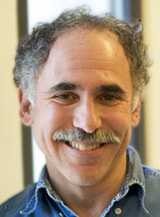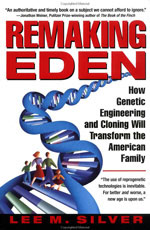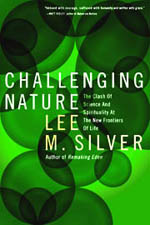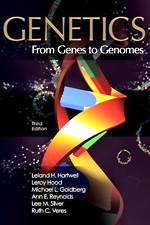|
Biography
Presentations
Publications/Writings
Books
Princeton teaching
|
REMAKING EDEN
Cloning and Beyond in a Brave New World.
By Lee M. Silver. 315 pp. New York: Avon Books. $25.
Those biologists who tend toward irreverence say their conservative peers
have one standard response to any really startling advance in science.
It comes in three stages.
First stage: "It is impossible. No one will ever do it."
Second stage: "Sure, it can be done, but it violates all the most
sacred laws of God and man. It must be banned!"
Final stage: "It's no big deal. Actually, I did it myself 10 years
ago, but never bothered to publish."
News people contemplating the present eruption of "cloning" stories
should bear the sequence in mind, particularly the second stage. We haven't
reached stage three yet.
Virtually every major advance in biology during the last 40 years has evoked
that same knee-jerk outpouring of horror. The list includes the first deliberate
transfer of genes between microbes, the first transplantation of foreign
genes into humans, the use of amniocentesis to find defects in a fetus
and the use of in vitro fertilization to help infertile couples have children.
The last on this list of well-denounced techniques--fertilization in the
test tube--is now so common that it goes just by its initials IVF.
These and most of the other major advances of molecular biology were all
anathematized initially as dangerous, impractical, immoral and as attempts
by scientists to "play God."
It took a long time for researchers to develop the skills that led to the
cloning of Dolly, the history-making lamb born more than a year ago. But
the feat was just a logical, probably inevitable, progression from the
first successful IVF procedure that made possible the birth, in England,
of Louise Joy Brown. She is now almost 20 years old, the "pioneer" of
a procedure that, through 1994, had already led to the births of 150,000
babies worldwide, according to one survey's estimate. The procedure is
as safe as the natural process. In terms of the risk of birth defects,
it is safer.
But IVF was denounced before it was ever done in humans. One theologian--who
has also denounced cloning--once asserted that in vitro fertilization should
never be tried in humans until it was proved totally safe. There was much
evidence from animals that it was safe enough to merit a try, but, as the
theologian knew, absolute safety is impossible even in riding a subway
and you can't prove anything is safe enough for human use without ever
trying it in a human. He really wanted a permanent ban, but lacked the
candor to say so.
Both IVF and cloning are dividends from the incredible revolution in biology
that has transformed health care, the shape and focus of biological research
and human understanding of health, disease and life itself during the last
45 years. Almost every major feature of this revolution was denounced at
the start.
Politicians have usually been among the first naysayers. They commonly
find it prudent to deplore anything new when most voters are ignorant of
the subject and can be counted on to view it with superstitious dread.
Columnists and editorial writers have seldom been far behind.
As the 20th Century fades, the revolution in biology is moving faster and
further than ever before. The new century promises even more revolutionary
advances. They will lead to many valuable applications and some that will
be bad. Science writers have been reporting the progress and controversies
of this revolution. Other journalists cannot afford to ignore it much longer.
Revolutions change worlds.
In the prologue of his new book, "Remaking Eden: Cloning and Beyond
in a Brave New World," Lee M. Silver, a molecular geneticist and Princeton
University professor, says our biological species may actually be starting
on the road to dividing into two separate and distinct species some 10
centuries hence. He suggests the new species will be made up of humans
who benefit from hereditary changes induced by the techniques of genetic
engineering. The other species, our original Homo sapiens, will be people
whose parents, grandparents and earlier ancestors did not, or could not
afford to, give their offspring the advantages of artificially manipulated
genes to make them smarter, stronger and permanently immune to plagues
such as AIDS and various cancers. The idea of such a parting of the ways
is shocking, but Silver makes a persuasive case that it could happen.
This prediction, and some other unsettling glimpses of the conjectured
future, the author presents as fictional anecdotes within the detailed
discussion of hard facts that make up most of his book. The anecdotes are
neither frivolous nor unbelievable. He asserts that each flight of fancy
is a logical extrapolation from today's scientific realities. He outlines
those realities in clear language that offers a lot of education and food
for thought.
He doesn't claim that every predicted change will arrive on schedule, but
he cites hard evidence that they are all conceivable and many are probable.
But does cloning, or any of the other new realities, truly violate sacred
values? The answer to that question lies more in the realm of religion
than science. But bear in mind that, back in the 1940's, even the efforts
to develop polio vaccines were denounced by some zealots as immoral because
success would upset the natural, ages-old, plan of life.
How should news people respond now to this latest sensation called cloning?
First, don't be lulled into the illusion that it is a one-time "crisis" that
will go away and can be ignored just like all the other startling announcements
from biologists in recent years. In fact, none of the important advances
has gone away. The practitioners have just gone back to work on new ones.
The cloning of a human is more likely a beginning than an end. It will
almost certainly be done somewhere, sometime and probably much sooner than
people expect. Nobody would have thought Dolly was worth banner headlines
if her birth didn't imply progression to humans. Nor should proposed bans
be taken too seriously. Like other controversial ideas in the past, if
it is banned in one country, it will be taken up somewhere else.
There are legitimate and life-saving reasons for human cloning. Families
in desperate need will find ways around any ban. They have always done
so.
As Silver points out, the urge to have children of their own is one of
humans' oldest and strongest drives. Cloning would offer a new response
to looming tragedy.
Consider something already here: bone marrow transplantation. That procedure
saves lives from cancers and some other deadly diseases, but donors often
aren't available to those in desperate need. A cloned child offers an answer
to that dilemma.
To many it seems shocking to give birth to a child to save the life of
an older brother or sister. But it has already been done. Ethicists denounced
that case, too. But Silver notes that the parents who did it in hope of
producing a bone marrow donor for their dying daughter were successful
against long odds. They now have, and love, two daughters. Would it have
been more ethical to let the older daughter die and not have another at
all?
Within three weeks of the announcement of Dolly's birth, Silver learned,
through casual conversations, of two prominent IVF practitioners in different
countries who were already "anxious to move ahead with selected `patients.'" He
thinks many other teams may be ready and willing to start.
While cloning of a human has evidently not yet been accomplished, almost
the same feat has been done in several species in addition to sheep. The
list includes rhesus monkeys. Biologically they are close enough to humans
so that it would be surprising if success in a rhesus did not mean it is
feasible in humans, too.
How should news people prepare for the shock of human cloning? First, we
should rid ourselves of some common misconceptions. A human clone is never
an "it" but always a "she" or "he." The difference
is crucial, but has obviously been lost on some critics. One editorial
writer for a major newspaper described clones as "synthetic humans." A
theologian worried that a clone might not have a soul.
In fact, a baby cloned from cells of another person is, in every way, a
real human, not an artificial fabrication. Nor is that baby in any sense
a lesser being. He or she is a natural human baby and is an identical twin
of the person from whom the cells were taken for cloning, no more, no less.
The two individuals would have exactly the same set of genes, although
unlike identical twins who come spontaneously, the cloned baby and the
donor would have developed in different wombs and would be born years apart.
If the cloning was from an adult, the two twins would be born decades apart.
The time difference eliminates another widespread misconception--the idea
that the cloned baby is a "carbon copy" of the donor in all respects
including personality.
The adult who gets cloned will have a twin born into a different generation.
Not only will its fetal nutrition be different, maybe better, maybe worse,
but the whole life experience will be different. Those factors impinge
on intellect and personality.
Physical features will be uncannily similar between parent and cloned child.
Mental capacities may be nearly equal, too. But, personality? Think of
any two people, one of whom was born into the Great Depression generation
of the 1930's while the other emerged in the prosperous but rebellious
60's. They probably aren't even in the same political party, let alone
think alike.
That should help dispose of the popular stereotype of cloning as a gigantic
ego trip for a millionaire. It wouldn't happen often enough to have any
impact on our species and, anyway, probably wouldn't produce the result
the ego-tripster sought.
The time element also disposes of the other common stereotype--the dictator
who wants to use cloning and genetic engineering to raise a host of super-warriors.
No tyrant in history has ever been willing to wait a full generation for
his army to grow up. There are much easier ways to recruit the troops.
Altogether, the challenge of future news in cloning and human genetic engineering
evokes one of the essential truisms of our business: it helps to learn
something about the subject before you write or speak. That, believe it
or not, should even apply to columnists, editorial writers and TV personalities.
Ignorance may be bliss, but it makes bad journalism. Also, knee-jerk reactions
are even less defensible in covering science than party politics. The issues
are more important.
Knowledge and skepticism are always worthwhile when confronting dramatic
new claims by scientists or moral guardians. Will the new development always
be an expensive rarity, or can price and difficulty be reduced? Are its
hazards real and likely, or just debating points? You need to know the
facts and background. They are not hard to find. Does the team claiming
a breakthrough have any track record in that field? Who else is doing that
kind of work and what do they say?
As to the call for bans, does the outcry emerge from factual concerns or
is it knee-jerk politics to comfort some constituency?
The risks of reporting in this field are the traditional ones: getting
the story wrong; raising false fears or false hopes; being captured by
the propaganda of a pressure group. One avoids them by diligence, careful
reporting and healthy skepticism.
Finally, consider the big picture. Will the powerful new techniques emerging
from biological science be used sometimes by the wrong people for the wrong
reasons and with the wrong results? Of course they will. Why should this
be different from everything else humans have done?
Imagine an obscure African cave more than a million years ago, when a radical
young proto-human first showed the clan that fire can actually be made,
not just borrowed from a smoldering lightning strike.
What did the tribal elders say?
"This is dangerous. Look at the horrible burns it can cause. Look at the
forest fires that can erupt. And firemaking is sacrilege. It steals from the
Fire God. Imagine all the bad things that can befall us if we start doing this!"
The tribe didn't heed the warning, but, of course, the elders were right.
All sorts of bad things have happened.
Harold Schmeck, Jr., a 1954 Nieman Fellow, is a retired science writer
for The New York Times.
|
Hover over or click on books to order from Amazon.com
|



